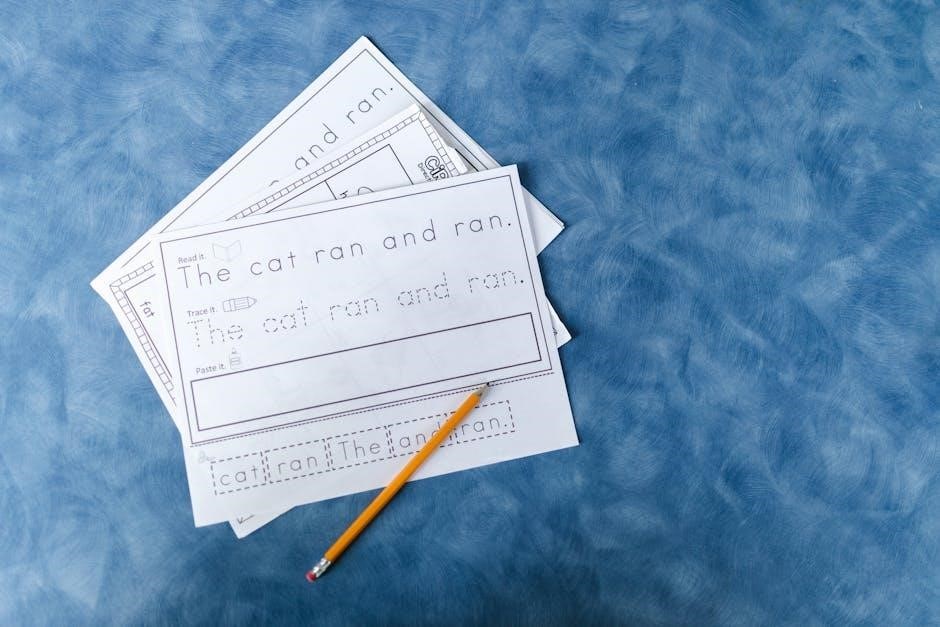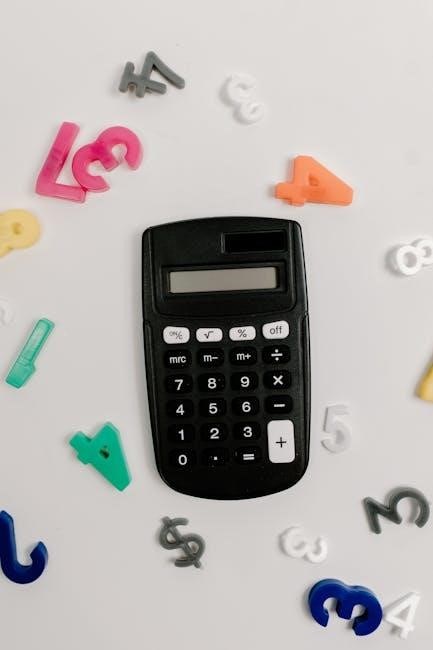
subtracting integers worksheet pdf
Subtracting integers worksheets are essential tools for mastering integer operations. These resources provide structured practice‚ helping students understand how to handle positive and negative numbers. Worksheets often include problems like (-3) — 5 or 7, 12‚ teaching the “Keep‚ Change‚ Change” method. They cater to various skill levels‚ offering problems with integers ranging from -20 to 20. Regular practice with these worksheets builds fluency and confidence in handling negative results‚ ensuring a strong foundation for more complex math concepts.

Rules for Subtracting Integers
Mastering the rules for subtracting integers is fundamental for accurate calculations. The “Keep‚ Change‚ Change” method is a helpful strategy: keep the first number‚ change the subtraction sign to addition‚ and change the negative number to positive. For example‚ (5 ‒ (-3)) becomes (5 + 3 = 8). When subtracting a positive from a negative‚ such as (-7 ‒ 4)‚ add the absolute values and keep the negative sign‚ resulting in (-11). Subtracting two negatives‚ like (-5 — (-2))‚ becomes (-5 + 2 = -3). The sign of the result depends on the larger absolute value: (3 — 7 = -4) and (-10 — (-3) = -7). Subtracting zero leaves the number unchanged: (9 ‒ 0 = 9) and (-4 ‒ 0 = -4). Remember‚ subtraction is not commutative‚ so order matters: (5 — 3 = 2) but (3 — 5 = -2)‚ and (-2, (-7) = 5) versus (-7 ‒ (-2) = -5); Consistently applying these rules ensures accurate integer subtraction.
Benefits of Practicing with Worksheets
Practicing with subtracting integers worksheets offers numerous benefits for students. These resources provide structured and focused exercises‚ helping learners develop a strong foundation in integer operations. Worksheets cater to different skill levels‚ ensuring that both beginners and advanced students can benefit. By solving problems like (-7) ‒ (-3) or 5 ‒ 12‚ students improve their understanding of negative and positive integers. Regular practice enhances mental math skills‚ allowing students to solve problems quickly and accurately without reliance on calculators. Worksheets also introduce various problem types‚ such as subtracting negatives or positives‚ reinforcing the “Keep‚ Change‚ Change” method. This consistent practice builds confidence and fluency‚ essential for tackling more complex math concepts. Additionally‚ worksheets are often graded or provide answers‚ enabling students to check their progress and identify areas for improvement. The repetitive nature of these exercises helps solidify the rules of integer subtraction‚ making them second nature. Over time‚ students develop a deeper understanding of how integers work‚ preparing them for algebra and higher-level mathematics. Worksheets are also convenient‚ as they can be completed anywhere‚ making them a valuable tool for homework or self-study. By dedicating time to these exercises‚ students can master integer subtraction and improve their overall math proficiency. Worksheets are a simple yet effective way to ensure long-term retention of these essential skills.

Where to Find Subtracting Integers Worksheets
Subtracting integers worksheets are widely available online‚ offering convenient access to practice materials. Websites like Math-Drills.com and Kuta Software LLC provide an extensive collection of free PDF worksheets. These resources cater to various skill levels‚ from basic subtraction of integers to more complex problems involving negative numbers. Many worksheets are designed for specific grade levels‚ ensuring they align with curriculum requirements. Additionally‚ platforms like EffortlessMath.com and SoftSchools.com offer printable worksheets that focus on mental math and problem-solving strategies. Teachers and parents can also find customizable worksheets on Teachers Pay Teachers‚ allowing them to tailor exercises to individual needs. Websites like Education.com provide interactive and downloadable resources‚ making learning engaging for students. Furthermore‚ a simple search for “subtracting integers worksheet PDF” on platforms like Google yields numerous results‚ including worksheets from educational institutions and independent educators. These resources often include answer keys‚ enabling students to check their work and track their progress. With so many options available‚ finding the right subtracting integers worksheet to suit learning needs has never been easier. Whether you’re a student‚ teacher‚ or parent‚ these resources provide a wealth of opportunities to practice and master integer subtraction.
Common Problems in Subtracting Integers
Subtracting integers can present several challenges‚ especially for beginners. One common issue is handling negative numbers‚ as students often struggle with the concept of subtracting a negative‚ which essentially becomes addition. For example‚ problems like ( (-3) ‒ 5 ) or ( 7 ‒ (-4) ) can be confusing due to the double negative. This often leads to errors in determining the correct sign of the result.
Another prevalent problem is borrowing or regrouping in subtraction‚ particularly when subtracting a larger integer from a smaller one. This is compounded when both integers are negative. Students may find it difficult to apply the “Keep‚ Change‚ Change” method correctly‚ leading to mistakes in their calculations. For instance‚ ( (-7) ‒ (-3) ) requires changing the subtraction to addition‚ resulting in ( -4 )‚ but students might incorrectly apply the rules and arrive at the wrong answer.
Additionally‚ students often face difficulty in determining the correct sign of the final answer. For example‚ in ( 5 ‒ 7 )‚ the result is negative‚ but some students may mistakenly believe the answer should be positive. This confusion stems from a lack of understanding of how integer signs affect the outcome of subtraction. Regular practice with worksheets can help reinforce these concepts and reduce such errors;
Lastly‚ word problems involving integers can be tricky‚ as students must interpret the context to determine whether they are adding or subtracting. For example‚ “The temperature dropped from 5°C to -2°C” requires subtracting a positive from a negative‚ resulting in ( -7°C ). Such problems test both mathematical skills and the ability to apply integer operations to real-world scenarios.
By addressing these common problems through guided practice and clear explanations‚ students can build a stronger foundation in subtracting integers and improve their overall math skills.

Tips for Effective Practice

Mastering the subtraction of integers requires consistent and focused practice. Start by understanding the fundamental rules‚ such as the “Keep‚ Change‚ Change” method‚ which simplifies subtracting negative numbers; Use visual aids like number lines or counters to reinforce concepts‚ especially for visual learners. Breaking problems into smaller steps can help manage complexity and reduce errors.
Practice regularly‚ even if only for a few minutes each day. Use flashcards or worksheets to drill subtraction facts‚ ensuring quick recall of basic operations. Focus on problem types that challenge you the most‚ such as subtracting larger numbers from smaller ones or handling double negatives. Gradually increase difficulty as confidence grows.
Incorporate real-world applications to make learning engaging. For example‚ calculate temperature drops or financial changes using integer subtraction. Review mistakes carefully to identify patterns and avoid repeating them. Utilize worksheets with answers to check progress and correct errors immediately.
Try teaching the concept to someone else or explaining it aloud. This reinforces understanding and highlights areas needing review. Mix mental math with written exercises to build both speed and accuracy. Lastly‚ stay patient and celebrate small improvements—consistent effort leads to mastery over time.

Checking Answers and Solutions
Verifying your work is crucial when practicing integer subtraction. Most worksheets provide answer keys‚ allowing you to cross-check your solutions. Start by comparing your answers to the provided solutions‚ ensuring they match exactly. If discrepancies arise‚ revisit the problem to identify where you might have gone wrong.

For complex problems‚ break down each step and verify individually. This methodical approach helps pinpoint errors‚ whether in sign handling or arithmetic. Use online tools or calculators to confirm calculations‚ especially for double-checking results. Understanding the reasoning behind each correct answer enhances learning and retention.
Reviewing incorrect answers is equally important. Analyze mistakes to avoid repeating them in future practices. Reflect on common errors‚ such as misapplying the “Keep‚ Change‚ Change” rule or miscalculating absolute values. Adjust your strategy based on these insights to improve accuracy and efficiency.
Regularly reviewing your progress helps track improvement over time. Celebrate correct answers and learn from incorrect ones. This iterative process ensures a solid grasp of integer subtraction‚ building confidence and competence in handling various numerical scenarios.

Mastering the subtraction of integers is a fundamental skill that forms the backbone of more complex mathematical operations. Through consistent practice with worksheets‚ students can develop a deep understanding of how integers work‚ including handling positive and negative numbers effectively. These resources provide a structured approach to learning‚ ensuring that concepts are reinforced through repetition and varied problem sets.

The availability of worksheet PDFs online makes it easier than ever to access high-quality practice materials. Whether you’re a student seeking additional practice or an educator looking for resources to support your teaching‚ these worksheets offer a reliable way to build proficiency in integer subtraction. The “Keep‚ Change‚ Change” method‚ along with other strategies‚ is clearly explained and applied in these exercises‚ making them an invaluable tool for learners of all levels.
By dedicating time to practice and reviewing answers‚ students can identify areas for improvement and solidify their understanding of integer operations. The iterative process of practicing‚ checking answers‚ and refining skills ensures long-term retention and confidence in tackling mathematical challenges. With persistence and the right resources‚ anyone can achieve mastery in subtracting integers and unlock the door to more advanced math concepts.